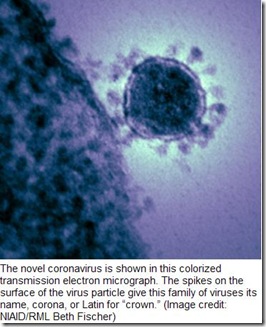[Source: US National Library of Medicine, full page: (LINK). Abstract, edited.]
Virol J. 2013 Oct 10;10(1):304. [Epub ahead of print]
Adaptive evolution of bat dipeptidyl peptidase 4 (dpp4): implications for the origin and emergence of Middle East respiratory syndrome coronavirus.
Cui J, Eden JS, Holmes EC, Wang LF.
Abstract
BACKGROUND:
The newly emerged Middle East respiratory syndrome coronavirus (MERS-CoV) that first appeared in Saudi Arabia during the summer of 2012 has to date (20th September 2013) caused 58 human deaths. MERS-CoV utilizes the dipeptidyl peptidase 4 (DPP4) host cell receptor, and analysis of the long-term interaction between virus and receptor provides key information on the evolutionary events that lead to the viral emergence.
FINDINGS:
We show that bat DPP4 genes have been subject to significant adaptive evolution, suggestive of a long-term arms-race between bats and MERS related CoVs. In particular, we identify three positively selected residues in DPP4 that directly interact with the viral surface glycoprotein.
CONCLUSIONS:
Our study suggests that the evolutionary lineage leading to MERS-CoV may have circulated in bats for a substantial time period.
PMID: 24107353 [PubMed - as supplied by publisher]
-
------
Virol J. 2013 Oct 10;10(1):304. [Epub ahead of print]
Adaptive evolution of bat dipeptidyl peptidase 4 (dpp4): implications for the origin and emergence of Middle East respiratory syndrome coronavirus.
Cui J, Eden JS, Holmes EC, Wang LF.
Abstract
BACKGROUND:
The newly emerged Middle East respiratory syndrome coronavirus (MERS-CoV) that first appeared in Saudi Arabia during the summer of 2012 has to date (20th September 2013) caused 58 human deaths. MERS-CoV utilizes the dipeptidyl peptidase 4 (DPP4) host cell receptor, and analysis of the long-term interaction between virus and receptor provides key information on the evolutionary events that lead to the viral emergence.
FINDINGS:
We show that bat DPP4 genes have been subject to significant adaptive evolution, suggestive of a long-term arms-race between bats and MERS related CoVs. In particular, we identify three positively selected residues in DPP4 that directly interact with the viral surface glycoprotein.
CONCLUSIONS:
Our study suggests that the evolutionary lineage leading to MERS-CoV may have circulated in bats for a substantial time period.
PMID: 24107353 [PubMed - as supplied by publisher]
-
------

Comment